#katharine page
Text

It's been a year since the It crowd doodle page! So here's another one <3
#art#i like using colour pallets that hurt ur eyes sorry <3#theres more richmond on this one for the noel girlies out there#the it crowd#it crowd#drawing#illustration#digital art#doodle#digital drawing#comic page#richard ayoade#katharine parkinson#chris o'dowd#matt berry#noel fielding#maurice moss#jen barber#roy trenneman#richmond it crowd#douglas reynholm#britcom
367 notes
·
View notes
Text
I'm just gonna pretend that Freddie never died

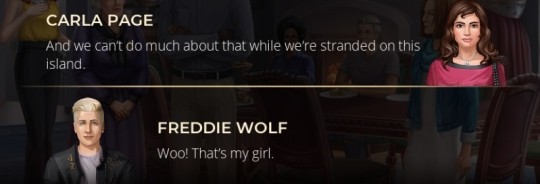




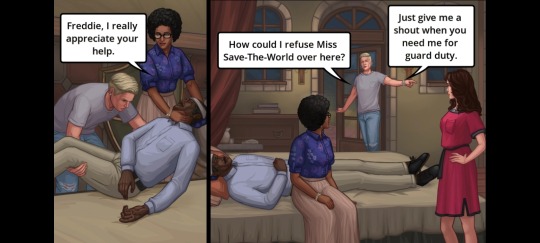
YOU CANNOT DO ALL THIS AND THEN FUCKING DIE? Nord current is evil for doing this I swear to god.
#carla page#freddie wolf#carla x freddie#freddie wolf x carla page#carla page x freddie wolf#freddie x carla#nordcurrent#murder by choice#we could have had it all#they just had to take him away from me huh?#margot st. germain#jax traynor#ruben navarro#samuel wilkinson#katharine bennet#portia frost#georgiana bird#lukas matonis#janet lim#he's not dead#he's just a little guy#he's so babygirl#he's still alive#death? what death?
5 notes
·
View notes
Text
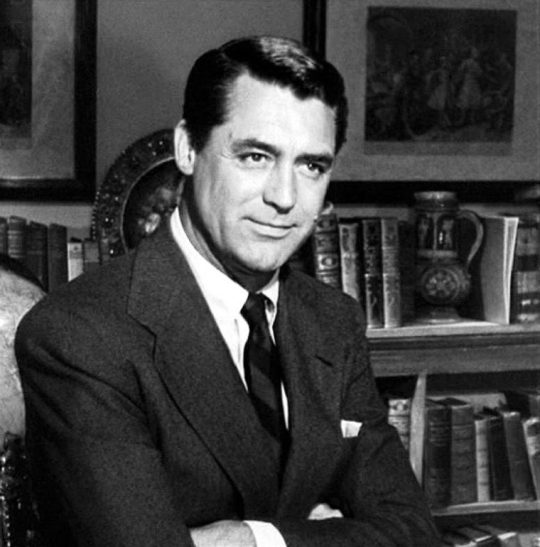

Propaganda
Cary Grant (The Philadelphia Story, His Girl Friday, Bringing Up Baby, Charade)—just the peak of old-school Hollywood sexuality. The glam, the suits, the gentle wit, the acrobatics, those eyes that always looked like they knew exactly what movie they were in and were laughing at the joke...
Vincent Price (Laura, Leave Her to Heaven, House on Haunted Hill, The Masque of the Red Death)—svelte, stylish, horrifying, beautiful, wickedly funny, camp and gorgeous and evil. he was an art connoisseur who advocated passionately indigenous art, he was an actual literal gourmet cook, he was so liberal he got greylisted during the mccarthy era for being too rad, he's my favorite muppets guest of all time
This is round 4 of the bracket. All other polls in this bracket can be found here. Please reblog with further support of your beloved hot sexy vintage man.
[additional propaganda submitted under the cut.]
Vincent Price propaganda:
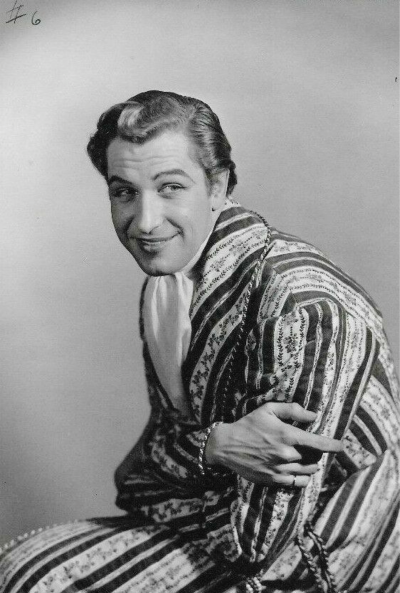
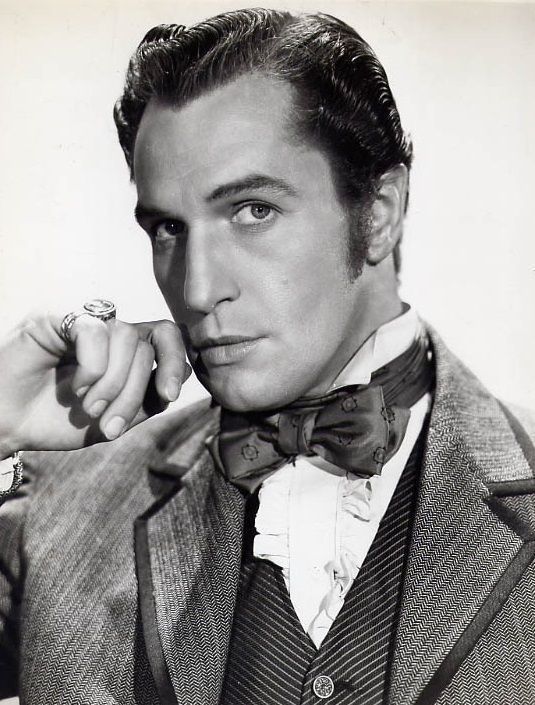
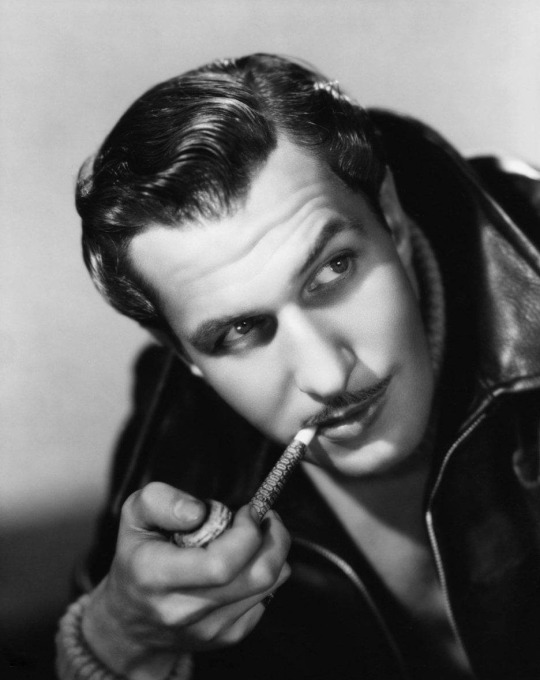
Submitted: this fancam
Submitted: this entire Tumblr page
Cary Grant propaganda:
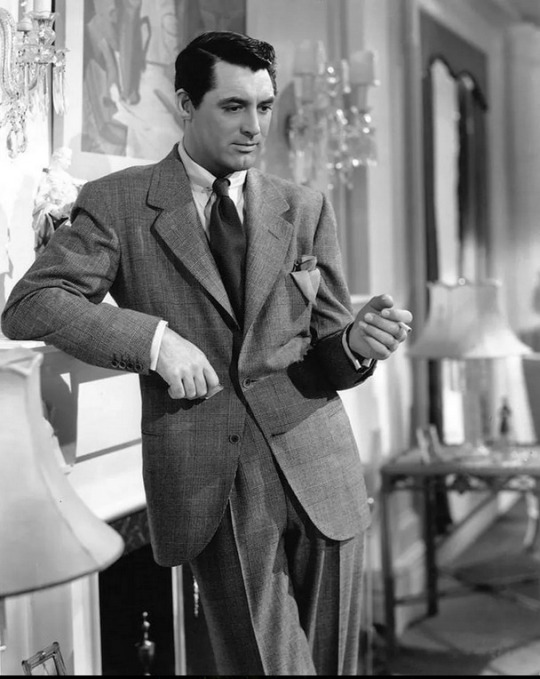
"My Golden Age of Hollywood professor, who was very outwardly gay himself, put it this way: Even though Grant's sexuality was kind of an open secret in Hollywood, the public couldn't know in any real way. But anybody could see that there was a queerness about him, so he was casted for roles where he physically embodies his masculinity in a non-explicit but queer way. Bringing Up Baby is famous for the scene where Grant wears a frilly robe (pictured below, but what people don't always realise is that he plays kind of an awkward nerd in that movie. He's a hot awkward scientist in a grand robe!!! Hot!!! In The Philadelphia Story, one of my famous movies of all time, he plays C. K. Dexter Haven, a rich, sarcastic, supposedly abusive guy. And yet, what we see is this laid back, dandy-ish figure, who absolutely does not feel threatened when a woman he supposedly loves (Katharine Hepburn) starts having feelings for, and hooks up with another guy (James Stewart). He lets a drunk Stewart into his office and helps him get his job back! Obviously that is the script and not the actor, but the whole film, and that scene in particular, shows him having this very queer attitude of openness toward Hepburn and Stewart, which is only amplified by the casting of Grant and his portrayal of the character. Anyway, this is not an essay arguing for The Philadelphia Story to be considered a queer film, all I will say is: he's super hot in it."
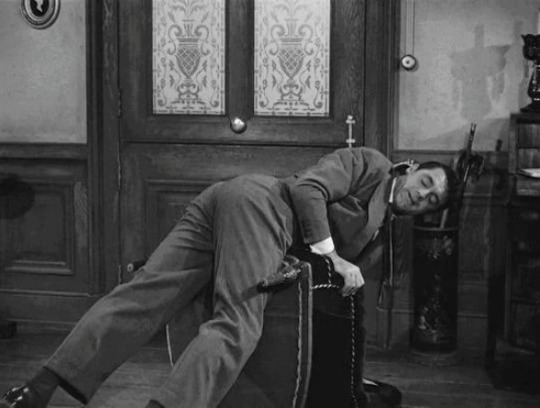
The link to the above mentioned frilly robe scene from Bringing Up Baby: "I just went gay all of a sudden!"

last minute cary grant propaganda: the last few paragraphs of that new vanity fair article about him and randolph scott that just came out 2 days ago on cary's birthday where he calls it "gravity collapse" and "love at first sight" and says their souls touched and and and i'm actually sharing this mostly because it makes me emotional but also because a vote for archibald is a vote for love. this is my message. apologies for sounding mildly insane.

2K notes
·
View notes
Text
My Grimoire Research Library
this is a list of my major resource I've referenced/am currently referencing in my big grimoire project. For books I'll be linking the Goodreads page, for pdfs, websites and videos i'll link them directly.
There are plenty of generalised practitioner resources that can work for everyone but as I have Irish ancestry and worship Hellenic deities quite a few of my resources are centred around Celtic Ireland, ancient Greece and the Olympic mythos. If you follow other sects of paganism you are more than welcome to reblog with your own list of resources.
Parts of my grimoire discuss topics of new age spiritualism, dangerous conspiracy theories, and bigotry in witchcraft so some resources in this list focus on that.
Books
Apollodorus - The Library of Greek Mythology
Astrea Taylor - Intuitive Witchcraft
Dee Dee Chainey & Willow Winsham - Treasury of Folklore: Woodlands and Forests
John Ferguson - Among The Gods: An Archaeological Exploration of Ancient Greek Religion
Katharine Briggs - The Fairies in Tradition and Literature
Kevin Danaher - The Year in Ireland: Irish Calendar Customs
Laura O'Brien - Fairy Faith in Ireland
Lindsey C. Watson - Magic in Ancient Greece and Rome
Nicholas Culpeper - Culpeper's Complete Herbal
Plutarch - The Rise and Fall of Athens: Nine Greek Lives
R.B. Parkinson - A Little Gay History: Desire and Diversity Around the World
Rachel Patterson - Seventy Eight Degrees of Wisdom: A Tarot Journey to Self-Awareness
Raleigh Briggs - Make Your Place: Affordable & Sustainable Nesting Skills
Robin Wall Kimmerer - Braiding Sweetgrass
Ronald Hutton - The Witch: A History of Fear in Ancient Times
Rosemary Ellen Guiley - The Encyclopaedia of Witches and Witchcraft
Thomas N. Mitchell - Athens: A History of the World's First Democracy
Walter Stephens - Demon Lovers: Witchcraft S3x and the Crisis of Belief
Yvonne P. Chireau - Black Magic: Religion and The African American Conjuring Tradition
PDFs
Anti Defamation League - Hate on Display: Hate Symbols Database
Brandy Williams - White Light, Black Magic: Racism in Esoteric Thought
Cambridge SU Women’s Campaign - How to Spot TERF Ideology 2.0.
Blogs and Websites
Anti Defamation League
B. Ricardo Brown - Until Darwin: Science and the Origins of Race
Dr. S. Deacon Ritterbush - Dr Beachcomb
Folklore Thursday
Freedom of Mind Resource Centre - Steven Hassan’s BITE Model of Authoritarian Control
Institute for Strategic Dialogue
Royal Horticultural Society
The Duchas Project -National Folklore Collection
Vivienne Mackie - Vivscelticconnections
YouTube Videos
ContraPoints - Gender Critical
Emma Thorne Videos - Christian Fundie Says Halloween is SATANIC!
Owen Morgan (Telltale) - The Source Of All Conspiracies: A 1902 Document Called "The Protocols"
The Belief it or Not Podcast - Ep. 40 Satanic Panic, Ep 92. Wicca
Wendigoon - The Conspiracy Theory Iceberg
Other videos I haven't referenced but you may still want to check out
Atun-Shei Films - Ancient Aryans: The History of Crackpot N@zi Archaeology
Belief It Or Not - Ep. 90 - Logical Fallacies
Dragon Talisman - Tarot Documentary (A re-upload of the 1997 documentary Strictly Supernatural: Tarot and Astrology)
Lindsay Ellis - Tracing the Roots of Pop Culture Transphobia
Overly Sarcastic Productions - Miscellaneous Myths Playlist
Owen Morgan (Telltale) - SATANIC PANIC! 90s Video Slanders Satanists | Pagan Invasion Saga | Part 1
ReignBot - How Ouija Boards Became "Evil" | Obscura Archive Ep. 2
Ryan Beard - Demi Lovato Promoted a R4cist Lizard Cult
Super Eyepatch Wolf - The Bizarre World of Fake Psychics, Faith Healers and Mediums
Weird Reads with Emily Louise -The Infamous Hoaxes Iceberg Playlist
Wendigoon - The True Stories of the Warren Hauntings: The Conjuring, Annabelle, Amityville, and Other Encounters
#I'm writing this while watching the new SovietWomble video#good way to spend 3 hours#witchblr#witch#witchcraft#pagan#pagan witch#kitchen witch#paganism#hellenic pagan#hellenic witch#grimoire#digital grimoire#book of magic#grimoire resources#witchcraft resources#resource list#witch masterpost#eclectic pagan#witchy#grimoire tips#grimoire inspo#grimoire inspiration
290 notes
·
View notes
Text
Bengiyo's Queer Cinema Syllabus
A few months back I was chatting with @bengiyo when the subject of queer cinema came up (unsurprising considering…ya know, the whole being BL buddies thing). As a semi-recent queerness realizer, and a Certified Baby Gay(™), Ben took it upon himself to share a post between himself and @shortpplfedup that inspired @the-conversation-pod and which also included a Completely Hypothetical Queer Cinema Syllabus Build Up to BL for Baby Gays. According to @bengiyo this started as a thought experiment.
But, unfortunately or…fortunately? for him, I constantly crave queer media, and @waitmyturtles and her Old GMMTV Challenge have inspired me to try my hand at working my way through this syllabus. I cannot guarantee that I will finish all these films. I have no idea how long it would even take, but I wanted to at least try!
I have been saying I would do this for months now, but I am inundated with BL content, and getting more every day, so I have been pushing it to the side. BUT! This evening a local movie theater played The Birdcage (1996) and I went and bought tickets and decided now was as good a time as any to get this started, I am hoping to take a page out of Turtle’s book and write notes/thoughts on the movies I end up watching. Forgive me the long winded introduction, but I figured some context would be nice if this ends up being a thing I stick with. So without further ado…
The Birdcage (1996) [Comedy]
Syllabus Unit 6: Gems

Summary: A gay cabaret owner and his drag queen companion agree to put up a false straight front so that their son can introduce them to his fiancée's right-wing moralistic parents.
Characters:
Armand: Gay cabaret owner, played by Robin Williams
Arnold: Drag queen partner, played by Nathan Lane
Val: Armand’s son, played by Dan Futterman
Agador: Armand and Arnold's maid? friend? live in slutty pool boy? played by Hank Azaria
Katharine: Val's biological mother, played by Christine Baranski
Overall Reflection
This is a film I had never seen before. Hell, I didn’t even know it existed until around the time Ben shared his syllabus, and someone reblogged a scene from it that ended up on my dashboard. This was an interesting film to experience in theaters, because while watching with an audience made the funny bits funnier, there were also moments that I absolutely did not read as funny that other people did, and I didn’t know how I felt about that.
This film is set primarily in South Beach, Florida and partly in a drag club, which meant that the only thing I could think about whenever the drag club was on screen was Palace, the gay bar, drag brunch, queer club spot in Miami. On the other funny casual note, as a Floridian I feel seen by the moment where Katharine calls and says she’s going to be late, and it zooms out to show she is stuck at the bridge. Real.
I feel like the majority of gay media I have consumed in my life very much centers around two very masculine characters. So it was really nice to watch a story that involved more femme characters, and that the femme characters were not left as the butt of the joke. Which I recognize might be ironic considering this is a comedy and therefore there are jokes abound. But, when you compare the femme character in something like Legally Blonde, to the femme characters here, they are allowed to be dramatic, and they are allowed to trip and fall, but the love that Armand has for Arnold is palpable, they squabble and they get annoyed at each other, and they hurt each other, but they are partners, and they love each other too, and it shows throughout the film.
This sounds fucked up, I guess, but I love the undercurrent of pain that is threaded throughout the story. The way that Val starts off seeming like he is very content with the way he grew up, the parents that he had. The way that Val feels so so loved by his Dads, and he hurts them anyway. Because he is scared, because he loves Barbara and he knows that she is good, and that her parents aren’t, and that he has to hide his family. But in making them hide who they are, he is hurting them and at first you can see and feel the ways that Armand is trying to rebel against it. You can tell that initially he is angry, disappointed, upset, incredulous:
“Yes, I wear foundation. Yes, I live with a man. Yes, I'm a middle- aged fag. But I know who I am, Val. It took me twenty years to get here, and I'm not gonna let some idiot senator destroy that. Fuck the senator, I don't give a damn what he thinks.”


gifs by @hellboys
It is one of my favorite lines in the film. Because Val needs to be called out on exactly what he is asking his father to do for him. Because Armand's pain is visceral in this moment. But Armand loves his son and so eventually he relents.
Arnold’s presence and importance in Val’s life are constantly disregarded and he is allowed to be upset, and Armand is allowed to constantly put his son’s engagement and wedding in jeopardy to prioritize his partner and his partner’s feelings, because Arnold is a part of this family, and to hide him away is unfair.
I certainly had to grapple with some complicated emotions around the character of Val. I could understand where he was coming from, that he loves his fiancee and that their families have to meet, and that it is almost certainly physically safer for everyone if his parents are not visibly and obviously queer around the ultra conservative moralist senator. But the ways he ends up exhibiting casual disdain, anxiety, and judgment around the aspects of his parents’ home, his parents’ friends, his parents’ themselves makes me kinda hate him a little bit. It is hard for me not to see Val as entitled, not to consider him low-key dickish, because of how frequently he seems to get annoyed and disappointed that Armand and Arnold are not acting straight enough, that their house isn’t straight enough, that their family isn’t straight enough. But the film does not shy away from the mental toll it takes.
Were there aspects of the film itself I didn’t like? Honestly, not really. There are some jokes and terminology that do not fully stand the test of time, so if I watch it with a modern lens I think I would give it a 9.5. If I watch it in the context of the time it was written, I would probably give it a 9.8. But watching it in theaters certainly altered the way I engaged in certain scenes.
Mostly with the “I know what you’re thinking. You’re thinking dressed like this, I’m even more obvious” scene.

gif by @rosalie-starfall
Because people in the theater were laughing during this moment. Which is not to say I am judging them, I’m not mad at them for finding the moments leading up to that scene funny. I can understand how Arnold constantly having to catch himself and change his body language could come off as funny. But there is a weight to that scene for me that made the laughter feel incongruous. It is, in my opinion, an incredibly impactful scene. And it was hard for me to fully embrace that moment the way I know I would have if I was alone, after I realized that not everyone reads that scene as a serious one.
(Side Note: When I was looking for pictures of the movie poster, I found three different versions of it, and I chose the one above because it was the most intriguing to me in the way it presents Arnold. Because it is the only one of the posters that puts Arnold in a suit.)
The other moment, that I think I would have had a stronger response to if I was alone, was the moment near the end where Val takes off Arnold’s wig and introduces Arnold as his mother.

gif by @nicholasbritel
If I had watched this scene alone, I think there is a very high likelihood I would have gotten teary eyed during that moment. Because Val has spent so much time throughout this film trying to hide Arnold away. Wanting to send him off for the evening so they didn’t have to worry, trying to replace him with his biological mother, who he had never really met just for the sake of maintaining appearances.
Arnold LOVES Val. It is glaringly obvious from the first moment they share a screen that to Arnold, that is his kid. And I cannot imagine what it must have felt like for Arnold to literally have his every move critiqued and criticized for acceptable levels of gayness by his son and his partner. To feel unwanted by his son and his partner. To feel replaced by his son and his partner. He deserves to see and hear his son choose him, to know that Val considers Arnold his parent. Especially when Val’s biological mother is standing right there.
And as for the comedy aspect of this movie? I mean, it’s Robin WIlliams and Nathan Lane so it is obviously going to be a truly hilarious film all the way through.

gif by @argentinosaurus
Where does it fall in my By, For, About Queers Categorization?

For and About
Any piece of media that places queer characters at the center of it is something I would categorize as “About Queers”
As far as I can tell, the writers and director are not queer. I consider films to be made By Queers when a queer person has a role in controlling how the story unfolds, usually this means a writer or director for me, actors too if they have any influence over changing the story. (As an example, The Last of Us Episode 3 would be something that I would place in a By Queers category because Murray Bartlet who played Frank is gay and also was consulted to shape the way the characters were written and the story played out.) While Nathan Lane is gay, and I am sure a number of actors who play side characters are as well, I do not know how much influence they had over the film itself. Which is why I am currently excluding it from the By Queers categorization.
And as for the For Queers aspect? That moment where Arnold appears in a suit and tie before the dinner party, where he appears so much more obviously gay when he’s in “masculine clothes” that is written for the people who understand. The undercurrent of pain I mentioned, that exists to be recognized by the people who understand. Also, I watched this at the movie theater and I saw what kind of crowd it drew lmfao.
Favorite moment in the film?
Well, I could go sappy with it and pick one of the scenes I referenced above, but I would be lying. My absolute, hands down, no contest favorite moment in this film was seeing Agador in this cropped tank top:


gif by @thevelvetgoldmine
Now, I know that Ben told me that the Units could be done in any order, but I think I want to start from Unit 1 and work my way through from there, so stay tuned for a write-up about Pariah (2011) from Unit 1: Coming of Age Post Moonlight.
#the birdcage#robin williams#nathan lane#bengiyo queer cinema syllabus#wka long post#queer stories#queer#lgbtqia
136 notes
·
View notes
Note
Howdy! Could we get a member introduction? I’d love to get to know y’all’s names and pronouns ^^
We actually did an essay and interview for the queer horror zine The Quiet Ones last year where we shared some fun intros! I've included screenshots of our intros here, but if you have a chance, you should check out the zine as well: it's run by a delightful group of queer authors and editors.
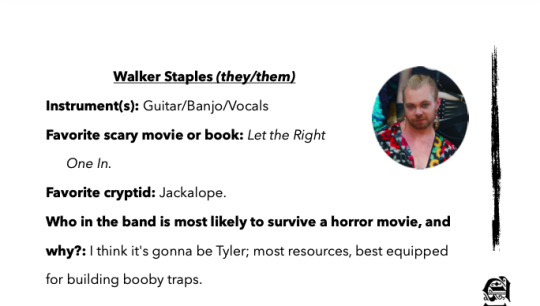


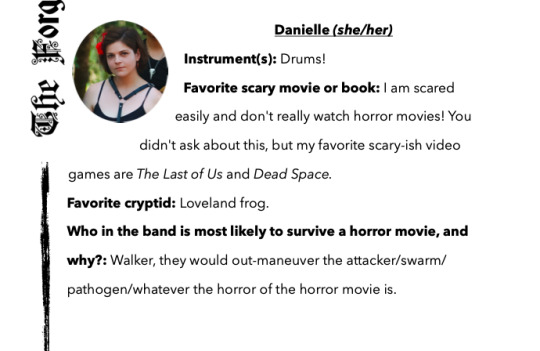
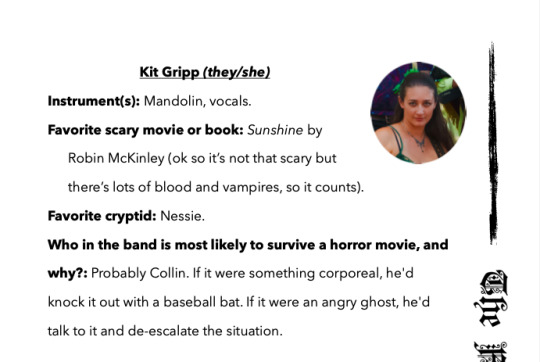
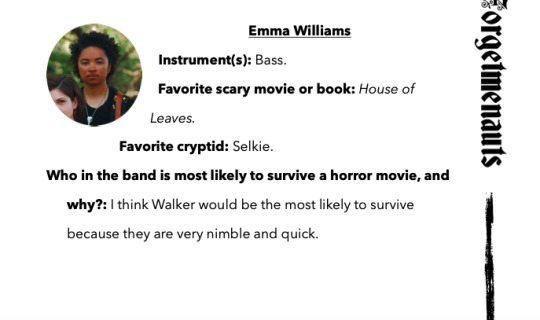
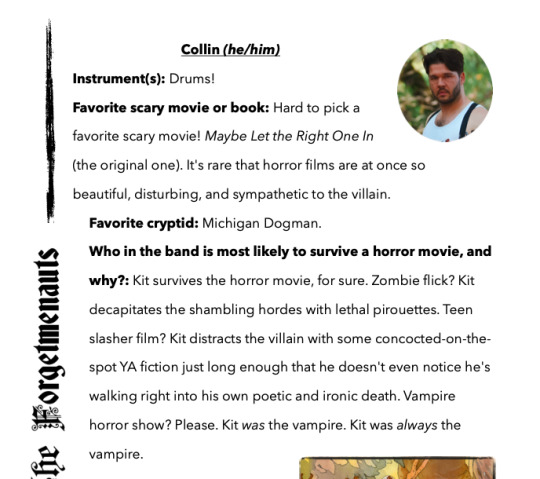
Here's the link to the issue with the Forgetmenauts feature: our bit starts on page 47.
(Fun fact: Kit is also an author and has had a couple of their short stories published in other issues of the zine, under their full name of Katharine Gripp. They're here and here if you want to check them out!)
Image text below the cut:
Walker Staples (they/them) Instrument(s): Guitar/Banjo/Vocals
Favorite scary movie or book: Let the Right One In.
Favorite cryptid: Jackalope.
Who in the band is most likely to survive a horror movie, and why?: I think it's gonna be Tyler; most resources, best equipped for building booby traps.
Tyler Gary (he/him) Instrument(s): Clarinet, Saxophone, Trombone, Keys.
Favorite scary movie or book: Recently I read Mexican Gothic and while it wasn't my all time favorite, it definitely captured some good haunting creepy vibes. Would recommend for the mushroom horror.
Favorite cryptid: The chupacabra.
Who in the band is most likely to survive a horror movie, and why?: I'd be the second or third to die. “Quick everybody, I have a plan! All we have to do is...“ *Dies in a horrible dramatic way*. I think Abe would be last to die. He would disappear early on and we would think he's dead but he actually just went on a hike and came back at the end.
Abe Finkelstein (he/him) Instrument(s): Cello, un-mic'd backup vocals and banter, howling.
Favorite scary movie or book: Oryx and Crake.
And I listened to a great podcast about Midsommar but will probably never have the guts to watch it.
Favorite cryptid: The Baba Yaga house.
Who in the band is most likely to survive a horror movie, and why?: Definitely Emma. She lives on a sailboat and is a great problem solver, and good at engineering. You might think I was on a hike but I was actually dead the WHOLE time.
Danielle (she/her) Instrument(s): Drums!
Favorite scary movie or book: I am scared easily and don't really watch horror movies! You
didn't ask about this, but my favorite scary-ish video games are The Last of Us and Dead Space.
Favorite cryptid: Loveland frog.
Who in the band is most likely to survive a horror movie, and why?: Walker, they would out-maneuver the attacker/swarm/ pathogen/whatever the horror of the horror movie is.
Kit Gripp (they/she) Instrument(s): Mandolin, vocals.
Favorite scary movie or book: Sunshine by Robin McKinley (ok so it’s not that scary but there’s lots of blood and vampires, so it counts).
Favorite cryptid: Nessie.
Who in the band is most likely to survive a horror movie, and why?: Probably Collin. If it were something corporeal, he'd knock it out with a baseball bat. If it were an angry ghost, he'd talk to it and de-escalate the situation.
Emma Williams Instrument(s): Bass.
Favorite scary movie or book: House of Leaves.
Favorite cryptid: Selkie.
Who in the band is most likely to survive a horror movie, and why?: I think Walker would be the most likely to survive because they are very nimble and quick.
Collin (he/him) Instrument(s): Drums!
Favorite scary movie or book: Hard to pick a favorite scary movie! Maybe Let the Right One In (the original one). It's rare that horror films are at once so beautiful, disturbing, and sympathetic to the villain.
Favorite cryptid: Michigan Dogman.
Who in the band is most likely to survive a horror movie, and why?: Kit survives the horror movie, for sure. Zombie flick? Kit decapitates the shambling hordes with lethal pirouettes. Teen slasher film? Kit distracts the villain with some concocted-on-the- spot YA fiction just long enough that he doesn't even notice he's walking right into his own poetic and ironic death. Vampire horror show? Please. Kit was the vampire. Kit was always the vampire.
112 notes
·
View notes
Text
So, you wanna prep for Lostbelt 6 by reading a bunch of fairy lore for background information. Luckily for you, I’m a turbo nerd when it comes to this particular brand of folklore. In this post I’ll be compiling links to assorted text and audio sources of information and entertainment related to all the real-world fairy lore that pops up throughout the chapter. I’m gonna try to avoid just wikipedia links as much as possible, so some of the text sources are gonna be a little dense, but that’s ye olde texts for you. This will be semi-ongoing as things pop up, so you can keep an eye out if you want!
Note: I’ll try to keep the spoilers to a minimum, but there will be possible spoilers as to what’s in the chapter ahead, so watch out!
Without further ado, here’s the list under the cut:
HUGE MASSIVE CONTENT WARNING: Many of these texts are going to have adult themes and triggering content, particularly sexual assault, rape, and general non-consent in romantic or sexual relationships. I’m going to start including individual warnings for texts where I know it comes up, but even if I don’t note it, please proceed with caution and take care!
A Dictionary of Fairies: Hobgoblins, Brownies, Bogies, and Other Supernatural Creatures by Katharine Mary Briggs - Exactly what it sounds like on the tin. Here’s where you can read about all the different fairies and creatures that tend to be more in short folktales, from baobhan sith to barghests to Ainsel and beyond, all in alphabetical order. If you find a fairy name you want to look up, it’s probably going to be in here somewhere.
A Midsummer Night’s Dream by William Shakespeare - I mean c’mon man. C’mon. There could always be a first for someone though, so if you are that someone - this is the most famous work featuring Oberon the fairy king, and the big one that F/GO and basically all other post-Billy Shakes media works pulls from. If you’d rather watch a staging of the play instead of read a script, here are some performances by Rice University and the Palm Beach Shakespeare Festival, and if those two in particular aren’t your jam I guarantee you there’s going to be a staging somewhere you can watch. As a bonus, here’s an absolutely lovely musical arrangement of “Philomel, With Melody” (AKA the lullaby Titania’s fairy servants sing to her) by the band Caprice. It’s not the most relevant, I just want to share it because it’s nice. WARNING: The crux of the play revolves around a love potion plot, so there will be themes of manipulation, non-consent, and potential sexual assault played for laughs and romance. It’s arguably mild compared to some of the other texts on here, but I would still be careful!
Translations of Melusina (Melusine) stories by D. L. Ashliman - D. L. Ashliman’s got a massive online treasure trove of folktales and folktexts, it’s always a fun time to go on a rabbit hole through his(their?) site. If you want stuff specifically relevant to Melusine though, here’s the page for her.
Versions of the Tam Lin ballad compiled at Tam Lin Balladry - this one’s going to be relevant because of the extremely high likelihood that NA will follow the JP merch labels and localize the “Fairy Knight” title as Tam Lin. Because it’s a ballad, there’s plenty of audio versions put to song, the most textually accurate one I can currently find being by Bob Hay & The Jolly Beggars. Besides that however, there are also versions by Steeleye Span, Fairport Convention, Tricky Pixie, and my personal favorite, the one by Anaïs Mitchell of Hadestown fame and Jefferson Hamer. If you want a more standard audio adaptation, the Tales of Britain and Ireland podcast will have you covered. WARNING: The start of the ballad is explicitly about sexual assault, with Tam Lin having been a rapist prior to meeting Janet. Janet’s own encounter is usually portrayed as consensual, she’s apparently a weirdo who heard the warnings and went “So that means FREE SEX?”, but some later versions do change her encounter into rape as a bizarre way of censoring her having sex out of wedlock. In addition, the ballad deals with themes of abortion. Basically, if any of this stuff is a trigger for you, I would proceed with extreme caution if you choose to listen or read.
Habetrot and Scantlie Mab - an archived version of a fairy tale about Habetrot. For similar stories, search for stuff under the Aarne-Thompson-Uther index type 501, “The Three Spinning Old Women”.
Historia Regum Britanniae (The History of the Kings of Britain) by Geoffrey of Monmouth - Now this one may not seem immediately obvious in its relevance outside of “hey look, Arthuriana!”, but trust me, This Is A Surprise Tool That Will Help Us Later. The relevant parts are going to start at Book 6, with Vortigern’s shenanigans. There’s also a podcast audio adaptation by Myths & Legends, split into part A, part B, and part C, if you would prefer that.
Official website for Knocknarea, or Cnoc na Riabh - Knocknarea is a big ol’ hill in Ireland with a bunch of Neolithic cairns on it, the most famous of which is claimed to be Queen Medb’s tomb. For anything else related to Medb, go read the Tain.
The Wikipedia page for Cernunnos - this is the point where I have to give up on not linking wikipedia, alas, as the sources here are little too tiny and scattered. Cernunnos is a Celtic god from Gaul, he’s got horns, we’ve got his name and some archaeological depictions of him, and that’s basically it, because unfortunately no stories about him survived. If I can find a better source about him to link, I’ll drop it here.
Le Morte d’Arthur by Sir Thomas Mallory, Volume I and Volume II - Not including this initially was a huge oversight on my part, but this is pretty much The text for general Arthuriana and one of the really big ones that Fate takes influence from. You can read this for stuff about Morgause and Morgan, but it’s also just good to have on hand for anything with the Round Table in general.
I’ve also got a bunch of podcast episodes that don’t really fit in with any of the above that I’ll list here if anyone wants more dank audio content:
Robin Goodfellow: His Mad Pranks and Merry Jests by Tales of Britain and Ireland - Relevant if you want some alternative tales of Puck and Oberon. WARNING: The episode itself covers its warnings pretty good, but before you click - there’s a lot of adult content in this one, including the thumbnail image. Most of the stories adapted are going to get pretty bawdy even at best, and there’s one that explicitly involves an attempted rape that the titular character thwarts. Proceed with caution, and also maybe don’t listen in public.
Black Dogs and Englishmen: Black Shuck in English Folklore and The Barguest: Demon Dog, Silly Sprite or Spectral Hound?, both by Fabulous Folklore with Icy - Listen to these two if you want more info on barghests.
Scottish Halloween & Vampire Fairy Witches by Stories of Scotland - Listen to this if you want a retelling of a story involving the baobhan sith along with other Scottish traditions!
And that’s all I’ve got for right now! If I find any more relevant sources, or if someone directs me to said sources, I’ll be sure to add links to this post. Until then, happy reading and listening, and I hope everyone has fun with LB6!
#fate grand order#note: from what i've seen i'm like 90% sure katharine briggs is a perfectly respectable scholar of fairy lore#but if it turns out there's something wild i don't know then at the very least she's probably nasu's source#everything else is as legit as I can get right now#briggs is the most comprehensive of the bunch so if you only have time for one i'd recommend her book#but there's nothing wrong with dipping into a bunch of the others i've provided
120 notes
·
View notes
Text
just out of curiosity, here is some info on the Pages of Honour:
The King’s:
HRH Prince George of Wales (some rando he found on the street ig)
Lord Oliver Cholmondeley: 13, son of David Cholmondeley, 7th Marquess of Cholmondeley, and Rose Hanbury. David is Charles’ Lord-in-Waiting.
Master Nicholas Barclay: 13, is the son of Rose Trouton and solicitor Piers Barclay. Rose is one of the King's goddaughters and is the daughter of Sarah Troughton, who is the King's second cousin and served as lady-in-waiting to Katharine, Duchess of Kent for ten years. In 2022, she became one of the six women appointed as Queen's Companions to Queen Consort Camilla.
Master Ralph Tollemache: 12, son of Edward Tollemache and Sophie Johnstone. Edward is Charles’ godson and Ralph’s grandparents Lord Timothy Tollemache, 5th Baron Tollemache, and Lady Xa Tollemache are close friends of Charles and Camilla.
The Queen’s:
Master Gus Lopes: 13, the son of Camilla’s daughter Laura Lopes and her husband, Harry.
Master Louis Lopes:13, the son of Camilla’s daughter Laura Lopes and her husband, Harry.
Master Freddy Parker Bowles: 12, the son of Camilla’s son Tom Parker Bowles and his former wife, Sara Buys.
Master Arthur Elliot: 11, the son of Camilla's nephew, Ben Elliot and his wife, Mary-Clare Winwood.
112 notes
·
View notes
Text
THIS DAY IN GAY HISTORY
based on: The White Crane Institute's 'Gay Wisdom', Gay Birthdays, Gay For Today, Famous GLBT, glbt-Gay Encylopedia, Today in Gay History, Wikipedia, and more … February 18
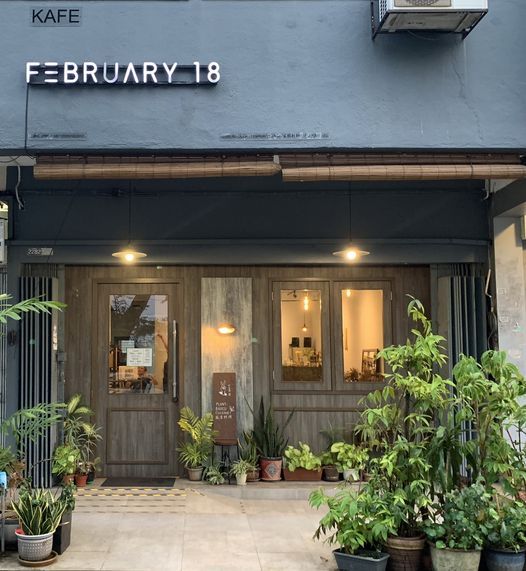
二月食吧


1907 – Billy De Wolfe, American actor, born William Jones (d.1974); A character actor, he was active in films from the mid-1940s until his death and was a good friend of Doris Day. He was never married, and is generally believed to have been a homosexual.
He signed with Paramount Pictures in 1943 and became a reliable comedian. His pencil-mustached and often pompous character contrasted humorously with the films' romantic leads. His best-known role of his Paramount tenure is probably the ham actor turned silent-movie villain in the 1947 fictionalized Pearl White biography The Perils of Pauline.
De Wolfe became known for his portrayal of fussy, petty men ("Never touch!," he would say imperiously whenever someone accosted him physically). A New York Times review of his 1948 film Isn't It Romantic? strongly criticized the way the other actors' material limited their performances, contrasting their performances with his: "But Mr. De Wolfe is nothing daunted. He rips up the place with great delight. The material is at his mercy. Likewise the scenery. And he chews it to bits."
He appeared regularly in guest roles on television, including the first two episodes of NBC's The Imogene Coca Show. He reappeared as Mr. Jarvis on CBS's The Doris Day Show, and co-starred with Larry Storch in a short-lived TV sitcom, The Queen and I. He often appeared on talk shows and in TV commercials, doing his "Mrs. Murgatroyd" drag routine. Wearing a hat and a shawl (but still sporting his mustache!), DeWolfe (as old maid "Phoebe Murgatroyd") would claim to be an expert on romance, and answered questions from the lovelorn.
Generations of TV viewers know Billy DeWolfe only by his voice: his is the voice of the frustrated magician in the Christmas perennial Frosty the Snowman. DeWolfe gave the role his usual fussy diction: "Mess-y, mess-y, mess-y! Bus-y, bus-y, bus-y!"


1931 – Charles Higham (d.2012) was an English author, editor and poet. Higham was a recipient of the Prix des Créateurs in 1978 and of the Académie Française and the Poetry Society of London Prize.He is best remembered as the writer of sensationalist biographies, especially Errol Flynn: The Untold Story.
Born in London, Higham was the son of MP and advertising mogul Sir Charles Higham. The younger Higham published two early books of verse in England, before moving to Sydney, Australia in 1954, where at 23 he became a prominent book and film critic. He became literary editor of The Bulletin, the country's leading weekly, in 1964, and published three more collections of verse.
Higham was named Regents Professor by the University of California, an honor accorded to leading literary figures in foreign countries, and while at UC Santa Cruz he discovered the lost footage of It's All True, Orson Welles's uncompleted Latin American triptych. In The Films of Orson Welles (1970) and in Orson Welles: The Rise and Fall of an American Genius (1985), he argued that Welles suffered from a "fear of completion" that led him to abandon projects when they were nearly finished because he could not bear to complete them. Friends of Welles, in particular Peter Bogdanovich, criticised this thesis. Newsweek devoted a full-page spread to Higham as a film detective and The New York Times engaged him as its Hollywood feature writer for the Sunday theatre Section.
Higham's first best seller was Kate (1975), the first authorised biography of Katharine Hepburn. This success was followed by Bette, the Life of Bette Davis, a biography of Lucille Ball, and The Duchess of Windsor (1988, 2005). His book Howard Hughes became the basis of Martin Scorsese's film The Aviator (2004). In this work "his assertions that Hughes had a romance with Cary Grant, was centrally involved in Watergate, offering material assistance to some of the conspirators, and quite possibly died of AIDS all raised eyebrows in the news media."
In 1980, Higham's "most sensational work", Errol Flynn: The Untold Story appeared. In this work he alleged that Errol Flynn was a bisexual fascist sympathiser who spied for the Nazis before and during World War II and had affairs with Tyrone Power, Howard Hughes, and Truman Capote. Tony Thomas, in Errol Flynn: The Spy Who Never Was (1990) and Buster Wiles in My Days With Errol Flynn: The Autobiography of a Stuntman (1988) attacked Higham's claims as fabrications, a claim substantiated by viewing the F.B.I. documents, which were altered - rather than quoted verbatim - by Higham.
In his autobiography Higham wrote of his molestation by his stepmother and reveals his 1952 marriage despite his growing awareness of his homosexuality. He and his wife Norine Lillian Cecil stayed great friends although she later adopted a lesbian lifestyle. Higham lived with his partner Richard V. Palafox, a nurse, until Palafox's death in 2010, in Los Angeles. Higham died on 21 April 2012 in Los Angeles.

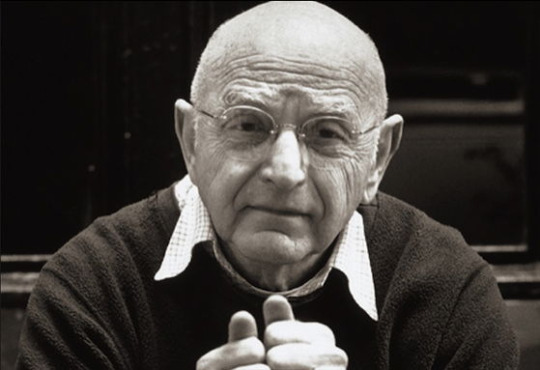
1932 – Duane Michals is an American photographer. Largely self-taught, his work is noted for its innovation and artistry. Michals' style often features photo-sequences and the incorporation of text to examine emotion and philosophy, resulting in a unique body of work.
In 1958 while on a holiday in the USSR he discovered an interest in photography. The photographs he made during this trip became his first exhibition held in 1963 at the Underground Gallery in New York City. Duane Michals settled in New York in the late 1950s and became known as a commercial and fashion photographer.
For a number of years, Michals worked in commercial photography, working for Esquire and Mademoiselle, and he covered the filming of The Great Gatsby for Vogue (1974). He did not have a studio. Instead, he took portraits of people in their environment, which was a contrast to the method of other photographers at the time, such as Avedon and Irving Penn. In 1968 Michals was hired by the government of Mexico to photograph the 1968 Olympic Games. In 1970 his works were shown at the Museum of Modern Art, New York.
His early work became well known for its insistent, and often humorous, use of the narrative series. Many such works actually incorporated handwritten text onto the images. Thematically, Michals has a recurrent fascination with making tangible the intangible realm of love, death, dreams, and wishes. His works deal with human sexuality, both straight and gay, but always in a charmingly moving and innocent manner.
Though he has not been involved in gay civil rights, his photography has addressed gay themes. As early as 1970, Michals plotted the psychic terrain of urban gay life with his series Chance Meeting, in which two men are seen to cruise each other within the sharply receding space of an alley that communicates both the encounter's intensity and also its potential for alienation.
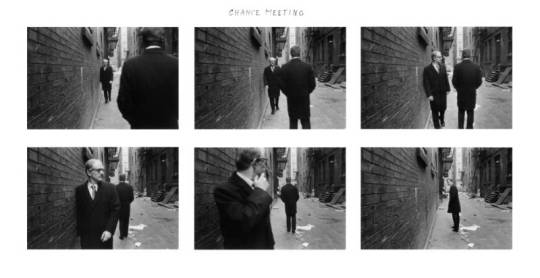
"Chance Meeting"
The Unfortunate Man (1978) allegorizes the crippling personal effects of gay criminalization, combining photographic image and coarsely handwritten text in what would become Michals's distinctive style.
His frequent incorporation of textual elements is not only Michals's accounting for reality beyond the visible world, but also his unassuming participation in the gay literary tradition that occasioned two books of photographic homages: Homage to Cavafy (1978) and Salute, Walt Whitman (1996). (Among Michals's two dozen books and catalogues, there is also a tribute to René Magritte, with whom Michals shared a fondness for sophisticated visual humor.)
With the publication of his illustrations of ten homoerotic poems by Constantine Cavafy, Michals identified himself publicly as gay, and thereafter one finds in his works images of tremendous tenderness between men, for example, Just to Light His Cigarette Was a Pleasure (1978) and How Nice to Watch You Take a Bath (1986).
In 1976 Michals received a grant from the National Endowment for the Arts. Michals also produced the art for The Police album Synchronicity in 1983, and Richard Barone's Clouds Over Eden album in 1993.
Michals has been in a relationship with his partner for 50 years. Though he has not been involved in gay civil rights, his photography has regularly addressed gay themes and quietly added to the storehouse of twentieth-century gay imagery.

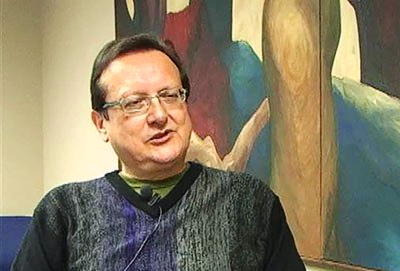
1952 – Daniel David Moses is a First Nations poet and playwright from Canada.
Moses, of Delaware descent on his father's side and Tuscarora descent on his mother's, was born in Ohsweken, Ontario, and raised on a farm on the Six Nations of the Grand River near Brantford, Ontario, Canada. In 2003, Moses joined the department of drama at Queen's University as an assistant professor. In 2019, he was appointed Professor Emeritus by Queen's University, Kingston, Canada.
He has worked as an independent artist since 1979 as a poet, playwright, dramaturge, editor, essayist, teacher, and writer-in-residence with institutions as varied as Theatre Passe Muraille, the Banff Centre for the Arts, Theatre Kingston, the University of British Columbia, the University of Western Ontario, the University of Windsor, the University of Toronto, the Sage Hill Writing Experience, McMaster University and Concordia University.
He is openly gay, and also claims "brothers and sisters among Two-Spirit people." Some of his works, therefore, reflect upon and explore the complexities of Native Two-Spirit or Queer identities


1954 – John Travolta is an American actor, dancer, and singer. There have been continuous claims that he is gay, some of these claims even leading to lawsuits.
Travolta first became known in the 1970s, after appearing on the television series Welcome Back, Kotter and starring in the box office successes Saturday Night Fever and Grease. Travolta's acting career declined through the 1980s.His career enjoyed a resurgence in the 1990s with his role in Pulp Fiction, and he has since continued starring in more recent films such as Face/Off, Swordfish, and Wild Hogs. Travolta was nominated for the Academy Award for Best Actor for Saturday Night Fever and Pulp Fiction. He won the Golden Globe Award for Best Actor - Motion Picture Musical or Comedy for his performance in Get Shorty. In 2014, he has received the IIFA Award for Outstanding Achievement in International Cinema at the 15th IIFA Awards held at the Raymond James Stadium in Tampa, Florida, in the United States.
Travolta married actress Kelly Preston in 1991. The couple had a son, Jett. In 2009, Jett died while on a Christmas vacation in The Bahamas. Their daughter, Ella Bleu, was born in 2000 and a third child, a son named Benjamin, was born in 2010 in Florida. Travolta and Preston have regularly attended marriage counseling; Travolta has stated that therapy has helped the marriage.
Travolta has been a practitioner of Scientology since 1975 when he was given the book Dianetics while filming the movie The Devil's Rain in Durango, Mexico. After the 2010 Haiti earthquake, he joining other celebrities in helping with the relief efforts, Travolta flew his 707 full of supplies, doctors, and Scientologist Volunteer Ministers into the disaster area.
In 2012, Fabian Zanzi, a former employee of Royal Caribbean Cruises, accused the "Grease" star of coming onto him aboard a ship in 2009. "Travolta forced his naked person and his erect penis against plaintiff's person causing plaintiff to experience pain, shock, embarrassment, distress and fear," the complaint filed in federal court in Los Angeles said. Later, lawyers for Zanzi and Travolta signed documents dismissing the action, which prevented Zanzi from refiling.
In May 2012, an anonymous masseur filed a lawsuit against Travolta citing claims of sexual assault and battery. A lawyer for Travolta said that the allegations were "complete fiction and fabrication" and someone wanting their 15 minutes of fame. Travolta's counsel also stated that his client would be able to prove that he was not in California on the day in question and asserted that Travolta would "sue the attorney and Plaintiff for malicious prosecution" after getting the case thrown out. A second masseur later joined the lawsuit making similar claims. Both lawsuits were subsequently dropped by the complainants and dismissed without prejudice.
In September 2014, Travolta denied claims made in January 2014 by his former pilot, Douglas Gotterba, that they had shared a sexual relationship while working for Travolta's aircraft company, Alto, for six years before leaving voluntarily in 1987. Gotterba argued that he was not bound by any confidentiality agreement during his term in the position.


1956 – John R. Stowe, a spiritual teacher, cofounder of Gay Spirit Visions, and founder of EarthFriends, was born. He lived a closeted gay existence until 1979, when he began a quest to discover what it meant to live as a gay man. As with many gay men, much of that struggle meant dealing with negative self images acquired from growing up in a world that does not accept homosexuality.
John began his studies of the living world rather traditionally, majoring in biological sciences and earning an M.S. degree in Biology/Ecology that led to a teaching position in a small university near Atlanta.
After several years of teaching - and a couple more spent traveling through Mexico, Central America, and Europe - he embarked on a study of natural healing. In 1981, John received certification from the Atlanta School of Massage as a Licensed Massage Therapist - having taught there concurrently.
After coming out, he found employment as a bodyworker/ masseur and pursued his spiritual and self-understanding quest through a spectrum of alternative spiritual options from the gay-informed Christianity of Episcopal priest Malcolm Boyd to channeller Andrew Ramer. He found bodywork as one tool that assisted the exploration of the inner self. He soon emerged as a spiritual teacher serving the gay community primarily in the Atlanta, Georgia, area.
In 1990, Stowe joined with a small group of friends who had pursued similar spiritual journeys, including Ramer, to found Gay Spirit Visions. The primary program of Gay Spirit Visions is an annual conference where gay men gather to explore alternative spiritual options. The work of the group provided the atmosphere for him to develop his book, Gay Spirit Warrior (1999). Gay Spirit Warrior was written to assist men begin an inner journey and start to experience the reality of the self, both positive and negative.
In 1984, Stowe had discovered flower essences, substances distilled from flowers and other plants by a particular method first discovered by Edward Bach, a British physician. Stowe began to make his own flower essences from flowers found in the Southeastern United States and use them in his bodywork sessions. In the mid-1980s he founded EarthFriends to manufacture and sell the essences he had developed. One line of products, Exploring Gayspirit Oils, is marketed primarily to gay men.

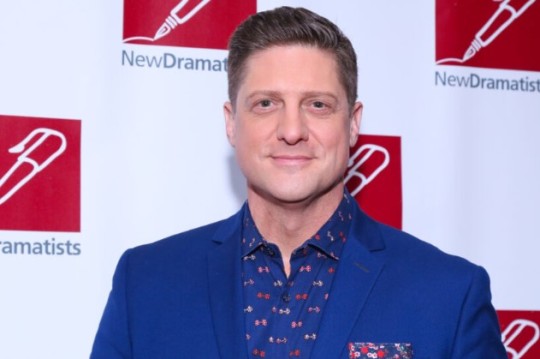
1969 – Christopher Sieber is an American actor. He is best known for his roles as Kevin Burke in Two of a Kind starring Mary-Kate Olsen and Ashley Olsen, and Lord Farquaad in Shrek the Musical. Christopher studied acting and musical comedy at The American Musical and Dramatic Academy in New York City. Sieber has appeared in Broadway musicals, including Into the Woods, Monty Python's Spamalot and Shrek The Musical. He is a two-time Tony Award nominee for his work in Spamalot and Shrek The Musical.
Sieber has starred in two television series: Two of a Kind with the Olsen twins and It's All Relative with John Benjamin Hickey and Harriet Sansom Harris.
While It's All Relative was being produced, Sieber came out as gay and said that he was happily partnered to actor and chef Kevin Burrows. They married on November 24, 2011, in New York City.
Sieber is involved with Broadway Cares/Equity Fights AIDS (BC/EFA) and has appeared in several of its Broadway Cares revues, among other events the charity produces.


Today's Gay Wisdom:
Audre Lorde
[{(o)}]|[{(o)}]|[{(o)}]|[{(o)}]| [{(o)}]|[{(o)}]
When I dare to be powerful, to use my strength in the service of my vision, then it becomes less and less important whether I am afraid.~ Audre Lorde, The Cancer Journals
Each time you love, love as deeply as if it were forever / Only, nothing is eternal. ~ Audre Lorde, Undersong
I have come to believe over and over again that what is most important to me must be spoken, made verbal and shared, even at the risk of having it bruised or misunderstood. That the speaking profits me, beyond any other effect. ~ Audre Lorde, from the essay "The Transformation of Silence into Language and Action", in Sister Outsider
Your silence will not protect you. ~ Audre Lorde from the essay "The Transformation of Silence into Language and Action", in Sister Outsider
I am who I am, doing what I came to do, acting upon you like a drug or chisel or remind you of your me-ness as I discover you in myself. ~ Audre Lorde, Sister Outsider
Poetry is not a luxury. It is a vital necessity of our existence. It forms the quality of the light within which we predicate our hopes and dreams toward survival and change, first made into language, then into idea, then into more tangible action. Poetry is the way we help give name to the nameless so it can be thought. The farthest horizons of our hopes and fears are cobbled by our poems, carved from the rock experiences of our daily lives. ~ Audre Lorde
I have always wanted to be both man and woman, to incorporate the strongest and richest parts of my mother and father within/into me -- to share valleys and mountains upon my body the way the earth does in hills and peaks. ~ Audre Lorde, Zami: A New Spelling of My Name


14 notes
·
View notes
Text
Victober Wrap-Up
The Romance of a Shop by Amy Levy: I read this one on October 1st. Very easy, very fun, if very underwritten, read about four sisters who open a photography shop. Gives a fascinating perspective on a different side of Victorian daily life.
The Europeans by Henry James: I forgot this one almost immediately after reading it, but I did enjoy it. The best way I can describe what I like about Henry James is that he writes like a woman. There's a concern for the inner lives of characters and the little moments of daily life that you usually don't see from male authors, and it works really well for the types of stories he tells.
Miss Meredith by Amy Levy: Short novella about a young woman who takes a job as a governess in Italy, and who gets a much nicer romance out of it than most of those types of characters. It's nothing ground-breaking, but it's fun to see her perspective on the setting, and the romance reminded me so much of some scenes from an old, beloved, abandoned WIP that I couldn't help liking it more than it probably deserved.
The Law and the Lady by Wilkie Collins: I loved the heroine of this book. I was so invested in her story. She was going to solve the mystery of her husband's past, no matter who stood in her way. Her (hilariously) pathetic wet napkin of a husband doesn't deserve her, but he needs her, and she loves him a lot, so I can root for them. It's astounding to me that a Victorian man can write such good female characters. They get to be people--strong-willed, intelligent, flawed, the center of their own stories rather than just a prop in someone else's. My love for Valeria papered over a lot of other flaws in this story (some not-great use of disabled characters, for one), and I'm seriously considering picking up another of his books next month. (They have perfect November vibes).
The Leavenworth Case by Anna Katharine Green: Not technically Victorian (it's American), but still the right time period. Apparently, this is where a lot of the detective genre started. I love the detective--he's got a quirk of not making eye contact with people, and I love that he's explicitly so working-class than he can't pass himself off as a gentleman for investigating this high-society crime--but I don't care about any of the characters, and the writing's not great. (Though it's kind of hilarious how often the narrator gets information because people come up to him and go, "You're a lawyer, right? Let me ask for advice about an intricate situation that just happens to tie into the case you're investigating.") I'm about 2/3 done with the audiobook, but it's going to be a bit of a slog to finish.
A Child's Garden of Verses by Robert Louis Stevenson: I'd probably find this a bit too cutesy most of the time, but I read this on a Sunday when I was feeling under-the-weather, and it was exactly what I needed. Very sweet, easy read.
Wuthering Heights by Emile Brontë: I made it a chapter and a half. It's a Hard No.
Diary of a Nobody by George and Weedon Grossmith: I heard it was short and funny, so I tried a couple of pages. Maybe there's a cultural divide, but I just wasn't feeling it.
The Odd Women by George Gissing: I tried a couple of chapter of the audiobook, because a story about women working as typists in late-Victorian England sounds right up my alley. I'm only two chapters in, but I'm debating whether to go further, because he already writes about women like a man--way too detailed descriptions of their physical appearance that suggest they're already decrepit in their early 30s, a suggestion that "we leave it to the men to decide if she'd be attractive"--and that doesn't bode well for a book with a female cast. It is just about to introduce the "progressive" woman who's about to drag the main characters into this newfangled job, so maybe it'd get better, but I'm not sure I'm invested enough to try.
20 notes
·
View notes
Text
361. Various Authors - Dragon #94 (February 1985)

Let's start with some sad news, I just learned that TTRPG and Video Gaming pioneer Jennell Jaquays passed away today. We've had some of her work featured here (the illustration for the cover for Dragon #21 for example) but most of her work is still to be covered in the future (she wrote and co-wrote modules for TSR later in the 80s, for example). She was in the hobby from the start, publishing fanzines and unofficial modules for D&D that go all the way back to the mid-70s. With her goes a bit of the history we are covering here.

Moving on to Dragon #94, we have a classic Clyde Caldwell cover wrapping what is a pretty great issue, full of juicy content for D&D fans. Gary Gygax brings us some rules changes for the Ranger class, concerning rules for tracking. Katharine Kerr covers the logistics of food in adventuring and Ed Greenwood gives us the ecology of the Chimera.

If this was all it would be a good issue, but there is more. Fans of Dragonlance will not want to miss Tracy Hickman's two pages on the history of the Knights of Solamnia while the centrepiece of the issue is the Creature Catalog II bringing 16 new monsters designed for AD&D adventures. There's a good variety of beasties here, although no particularly classic monsters. Loads of content here!
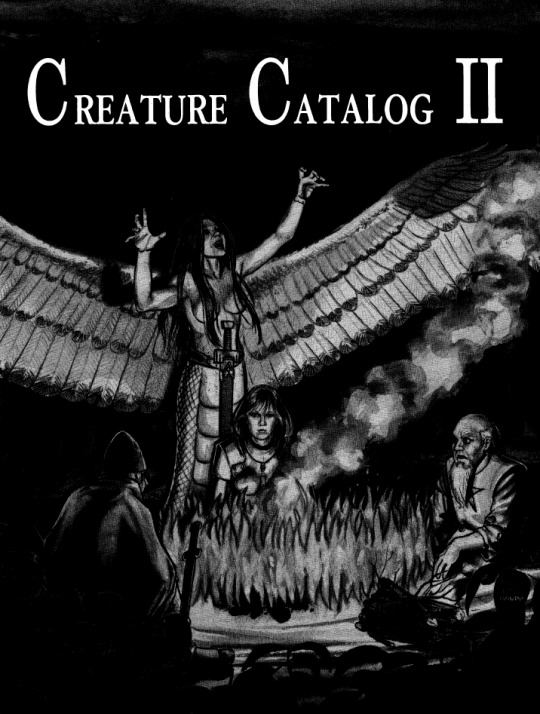
13 notes
·
View notes
Text
Hot Vintage Stage Actress Round 1


Katharine Cornell: Leslie Crosbie in The Letter (1927 Broadway); Elizabeth Barrett Browning in The Barretts of Wimpole Street (1931 Broadway); Juliet in Romeo and Juliet (1934 Broadway); Linda Page in No Time for Comedy (1939 Broadway); Cleopatra in Antony and Cleopatra (1947 Broadway)
Lynn Fontanne: Eliza Doolittle in Pygmalion (1926 Broadway); Nina Leeds in Strange Interlude (1928 Broadway); Katherina in The Taming of the Shrew (1935 Broadway)
Propaganda under the cut
Katharine Cornell:
The First Lady of Theatre was a lesbian in a lavender marriage so jot that down
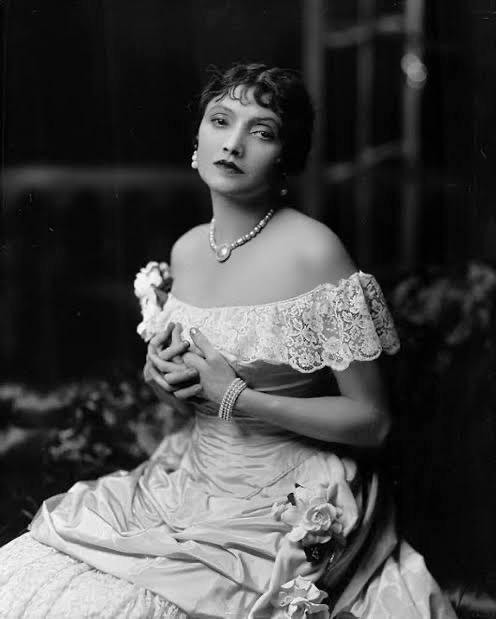


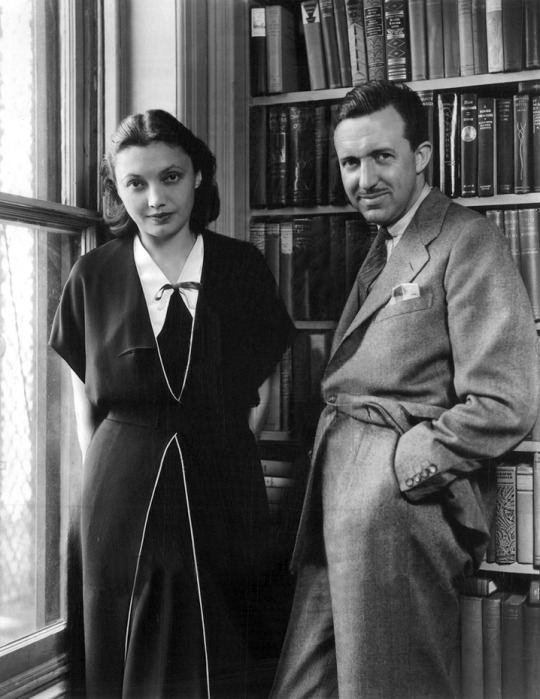


Lynn Fontanne:
I would give ANYTHING to have been a part of her polycule


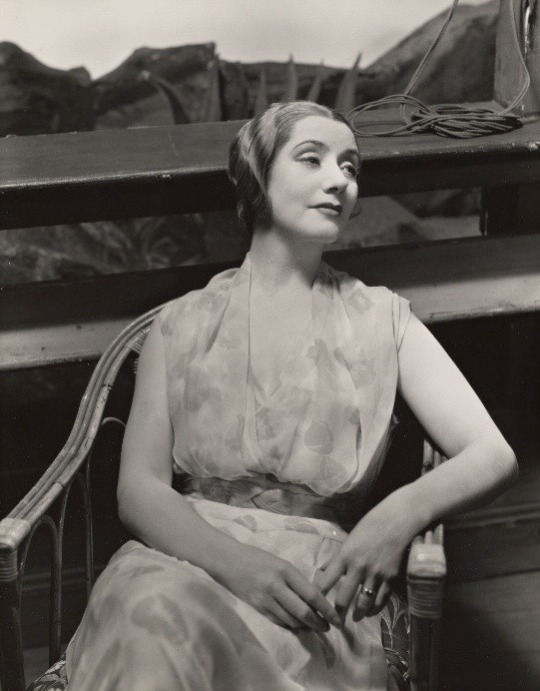


#vintagestagehotties#vintagestagepoll#vintage tournament#vintage poll#katharine cornell#lynn fontanne#ladies round 1#vintage ladies
8 notes
·
View notes
Text


Propaganda
James Stewart (The Philadelphia Story, It's a Wonderful Life, Mr. Smith Goes to Washington)—Ough I saw him first in It's A Wonderful Life, where he is very charming as a suicidal family man being absolutely crushed by capitalism. But then. The Philadelphia Story, in my opinion, should get the same kind of press The Mummy does for being a bisexual dream. Now I'm not really bi (not into women) and it's honestly up for debate whether i'm attracted to men or not, but COME ON!! The movie stars James Stewart as well as Cary Grant and Katharine Hepburn (and Ruth Hussey). Stewart plays a common working man, a journalist, to contrast with Grant's character, who is mega-rich. He is scrappy and hates rich people. Hot! They have a whole scene together where he's super drunk and being really physical with his acting, which I love because he is kinda wet noodle shaped. Hot! He carries Hepburn in his arms while singing Somewhere Over The Rainbow. Hot! He gets punched in the face by Cary Grant. Hot!!! In The Man Who Shot Liberty Valence, we get to see him portray an alternative type of masculinity, opposite John Wayne doing John Wayne. He is even more wet noodle-y, to put emphasis on his incompatibility with the rugged masculinity of the cow-boy, he wears an apron for a lot of the film, again, to blur his masculinity, and he gets shot. Hot! Also he's older here, if that's your thing. Long story short: He's giving librarian chic and The Philadelphia Story made me want to be poly.
Gilbert Roland (Camille, The Cisco Kid movies, The Bad and the Beautiful)—no propaganda submitted beyond pictures below the cut
This is round 2 of the bracket. All other polls in this bracket can be found here. Please reblog with further support of your beloved hot sexy vintage man.
[additional propaganda submitted under the cut.]

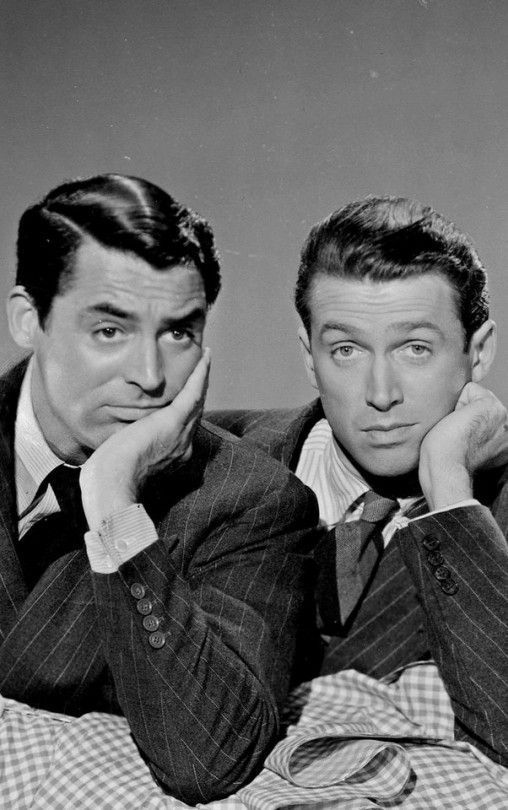
"Here he is next to Grant, in what I believe to be a promotional shot for The Philadelphia Story. Please don't get distracted by Grant (or do, i'm submitting him next)."

"He’s a nice guy and a good guy and deserves all the happiness and joy ever! Classic boy next door/class president kid that everyone loves for real. Stand-up for the Little Guy vibes. With a charming fun side!!"
Link to TCM page submitted for Stewart

"And here he is in colour! From Rope!"
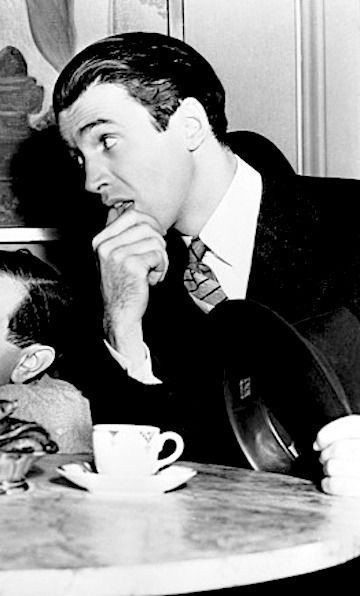

Propaganda for Gilbert Roland:

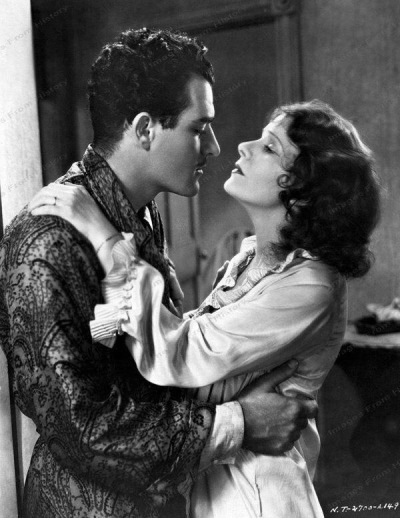


274 notes
·
View notes
Text
It's very interesting to notice how Disney's Beauty and the Beast draws inspiration not just from other versions of the fairy tale or from Disney's earlier fairy tale features, but from other love stories in classic Hollywood films and literature that were created for adults.
@starberry-cupcake's post on the ways that Disney's BatB changes the tale's core narrative parallel from the Cupid and Psyche myth to Pride and Prejudice is genius. It's slightly astounding that no one on the creative team has ever cited Pride and Prejudice as an influence: but maybe Austen's novel has become enough of a modern myth and influenced so many other love stories and comedies of manners that Disney's creative team really did write the parallels unconsciously. Of course the similarities can be overstated; Belle and the Beast are less mutually flawed than Elizabeth and Darcy, for one thing, and the Beast changes more while Belle changes less than their Austen counterparts do. (I might argue that Belle and the Beast more closely resemble pop culture's simplified ideas of Elizabeth and Darcy than they do Austen's actual characters.) But in terms of plot structure, the parallels are spot-on.
Even if the Austen parallels were accidental, though, the movie's creative team has freely admitted to other inspirations. Screenwriter Linda Woolverton has stated that there's a lot of Katharine Hepburn in Belle. That her characterization in general was strongly influenced by Hepburn's portrayal of Jo in the 1933 film version of Little Women (albeit with her tomboyishness toned down), and that her snappy arguments with the Beast in the dinner-invitation and wound-tending scenes were inspired by Hepburn and Spencer Tracy's similar bickering in their romantic comedies. The animators have also admitted to modeling Belle's appearance after such iconic Hollywood beauties as Elizabeth Taylor, Audrey Hepburn, and Natalie Wood. Photos of those three ladies were kept in the studio for the artists to literally draw inspiration from.
Then there are the other obvious parallels with other movies, which I seem to remember the trivia page of IMDB.com pointing out. For example, there are some obvious parallels with The Wizard of Oz. Belle's iconic blue and white peasant dress looks similar to Dorothy's iconic blue and white gingham dress, and like Dorothy, she's a dreamer trapped in a mundane workaday world, who longs to escape and have new experiences. The Beast's brief "stupid" hairdo during his makeover scene, with its curls and ribbons, also looks like the Cowardly Lion's mane after his makeover, while Lumiere, Cogsworth, and Mrs. Potts can respectively be viewed as counterparts to the Scarecrow, Tin Man, and Cowardly Lion themselves. A likable, helpful trio of sidekicks, with Lumiere as the unofficial leader who has all the bright ideas (no pun intended), Mrs. Potts as the kindest and gentlest one despite being made of a hard, cold substance, and Cogsworth as the comically nervous one who nonetheless proves to be braver than he seems. Meanwhile, a shout-out to another classic movie occurs when Belle stands on the grassy hill and sings "I want adventure in the great wide somewhere": an obvious homage to Julie Andrews' Maria at the beginning of The Sound of Music. Appropriately, we could argue that the plot structure of Disney's BatB mirrors The Sound of Music just as much as it does Pride and Prejudice. A free-spirited heroine doesn't fit in with her community; then she unexpectedly goes to live in a new household run by an unhappy, aloof master; at first she clashes with him, but soon she brings warmth and joy back into his life and softens his heart; their growing love for each other culminates in a romantic dance scene, after which she briefly leaves him and runs back to her old home (although for different reasons); but ultimately she goes back to him and they end up together. Fortunately, there are no Nazis in Beauty and the Beast to darken Belle and the Prince's newlywed life.
IMDB.com also notes some parallels with the 1958 Leslie Caron movie Gigi. The young male lead played by Louis Jourdan in that film is named Gaston. Like Disney's Gaston he's a playboy with a cocky attitude, and Gigi refuses to be his mistress just like Belle refuses to be her Gaston's wife. The characters go in completely different directions, though, since Gigi's Gaston redeems himself and gets the girl in the end, while the Beauty and the Beast Gaston... not so much. Lumiere's characterization is also clearly based on Maurice Chevalier, who plays a major role (and sings his most famous song, "Thank Heaven for Little Girls") in Gigi too.
Then there's the Beast's "death" in Belle's arms, which seems to draw strong inspiration from two romantic death scenes in earlier Hollywood classics. First of all, the camera angles are nearly identical to those of Tony's death in Maria's arms in the original 1961 version of West Side Story, as I remember IMDB.com pointing out. The fact Belle's appearance was already partly modeled after Natalie Wood probably helped to bring that scene to the animators' minds. But I also think they drew inspiration from another famous Hollywood death scene: the death of Greta Garbo's Marguerite in 1936's Camille. I've never seen anyone else notice the similarity, probably because the characters' genders are reversed, but I've noticed it ever since I first saw the Camille scene in the 1982 version of Annie. The dialogue has clear parallels, with the dying character resigned to their fate because death will set them free from their life as an outcast (the Beast's "Maybe it's better this way" echoes Marguerite's "Perhaps it's better if I live in your heart, where the world can't see me"), while their lover urges them "Don't think such things"/"Don't talk like that" and tries to convince them that everything will be fine. Then the moment of death is conveyed by Marguerite and the Beast's eyes, as they roll upward and then drift closed, and the reactions of Belle and Robert Taylor's Armand are very similar, as they both pause in horror, then plead "No, no... don't leave me..." and bury their faces in their beloved's chest in anguish.
In all these inspirations and homages, I think it shows that with Beauty and the Beast, Disney set out to create not just another children's movie, but a movie in the spirit of a Golden Age Hollywood classic that adults could enjoy too. In particular, they set out to create a genuinely romantic picture, which adult couples could enjoy as a "date movie" just as much as their kids would enjoy it as a fairy tale. And as we all know, they succeeded with flying colors!
@ariel-seagull-wings, @themousefromfantasyland, @the-blue-fairie, @thealmightyemprex, @littlewomenpodcast, @adarkrainbow
#disney#beauty and the beast#1991#fairy tale#animated film#pride and prejudice#katharine hepburn#spencer tracy#little women#the wizard of oz#the sound of music#gigi#west side story#camille#classic hollywood#romance
195 notes
·
View notes
Text
January Reading Summary
I asked yesterday if people were interested in what I read this year so far, and they seemingly were, so... here we go. You only have yourselves to blame.
Agatha Christie: Cat Among the Pigeons
I actually started this one last year--I read Christmas Puding around Christmas, finished it sooner than I thought I would, but enjoyed it (I generally like Christie), so I just picked up another Christie I found at home. Oh, boy. Bad idea. Yep, it didn't do it for me. The beginning was all over the place, because Christie was introducing all these POVs all over the place with a (technically) non-chronological storytelling, then we were almost halfway through the novel by the time the first murder happened, then in the conclusion there were elements so misguided and nigh-distasteful (and stupid) that it actually made me mad. Nope, do not recommend.
James Herriot: All Creatures Great and Small
Ah, an old friend. For those who are unfamiliar with Herriot's work: he was a vetenarian working in rural Yorkshire who started practicing in the early forties (changed to 1937 in his books), who then wrote several (slightly fictional) memoirs/collections of short stories about his life in the 1970s. ACGaS covers the period from the time he arrives at Yorkshire until he marries his wife. It's like a big mug of hot cocoa in a book form (that will sometimes make you cry). Everyone should read Herriot at least once.
James Herriot: Vets Might Fly
Another one of Herriot's works, this one *technically* covers his time spent in the RAF--I say *technically* because many of the chapters are like "so this thing happened during training that reminded me of one of my patients at home." Also lovely, but sadly my copy is fully of typos (I have his books in Hungarian, and my copy of ACGaS was published in 1980s, while this one in the 2010s).
R.F. Kuang: Yellowface
I've talked about this one here before. Brillant (I'd call it) pschyo-thriller and satire about the current state of the publishing industry.
Soman Chainani: Beasts and Beauty
Collection of retold fairytales which I DNF'd after three stories. In my defense, I went into enthusiastically, but the first story was... okay, the second was kinda eyeroll-worthy, and the third I couldn't make much sense of, so I just gave up.
Hannah Grace: Wildfire
Pretty much the same as Icrebreaker. Grace is really good at writing engaging characters and cammaderie, and I'm grateful for how she handles serious issues, but she still has much to work on her plots--some parts of the novel felt really episodic, like it had nothing to add to the overall narrative, while she stressed several times how important this end-of-the-camp talent show is for the female lead, only then to skim over the event in like two pages, without showing her thoughts about.
Mark Lawrence: The Girl and the Moon
...Sigh. This was a translation project, and I really can't say anything nice about this. It might be just me, because the author is apparently pretty much renowed, but I couldn't find a single element in it that I liked. Also the female lead's ending pretty much rivalled Alina's in the books in how unfulfilling and disappointing it was. Not to mention that the male author, who until that point handled the female character pretty well IMHO, had her say/decide on something that was downright disturbing, especially from a woman.
I also started reading Jennifer Saint's Ariadne and Katharine and Elizabeth Corr's Queen of the Gods in January, but I haven't finished those yet.
7 notes
·
View notes
Text
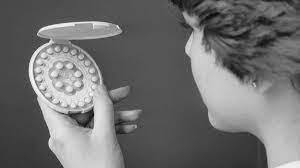
Image from History.com.
#OTW 1960: FDA Approves "THE PILL"
By Miriam Kleiman, Public Affairs
The FDA's May 9, 1960 approval of oral contraception, aka "the pill", transformed reproductive health. Women's health advocate Margaret Sanger spearheaded and activist/philanthropist Katherine McCormick funded the R&D needed for this medical research breakthrough to improve women's lives through "birth control."
Margaret Sanger, a nurse, coined the term “birth control” and dedicated herself to educating women. Her own mother had 18 pregnancies in 22 years and died from ovarian cancer. In 1914, she started a newsletter, The Woman Rebel, to "advocate the prevention of conception."
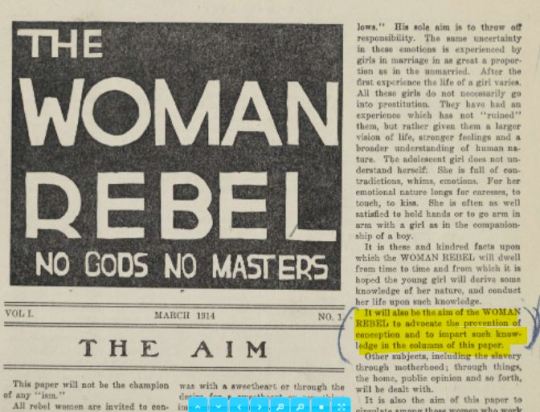
The Woman Rebel, No. 1; 3/1914.
Sanger was indicted repeatedly and even arrested on obscenity charges under the Comstock Laws (1873) which defined birth control as obscene and made it illegal to send contraceptive devices or even info about it through the mail.

United States v. Margaret H. Sanger; 8/25/1914, National Archives at New York. Emphases added.

Flyer from benefit held on eve of Sanger's trial for opening Brownsville Clinic. (Courtesy of Sanger Project).
Katherine McCormick heard Sanger speak in 1917 and grew convinced that women could only fully control their lives if they could control if and when they chose to bear children. She redirected her advocacy to the cause of birth control, even smuggling in diaphragms from Europe to New York at Sanger's request.
When her husband Stanley died in 1947, Katherine inherited an estate estimated worth almost $40 million (more than $500 million today). Margaret Sanger introduced her to Gregory Pincus who was doing pioneering research on fertilization and hormones.
Katharine funneled to Dr. Pincus more than $2 million ($25 million today), nearly all of the money used to support his lab's research and development of the contraceptive pill.
Read the National Archives Prologue Magazine story Rich, Famous, and Questionably Sane to learn how McCormick, who was blamed her husband's inability to consummate his own marriage, became the catalyst for the sexual revolution.

Women Hold Banner at National Women’s Conference, November 1977. NARA ID 7452290.
See also:
Records of Rights exhibit: Anti-Contraception Campaign 1914
DocsTeach: Indictment of Margaret H. Sanger, 8/25/1914
DocsTeach: Margaret Sanger: The Woman Rebel
DocsTeach: Reproductive Rights Documents
Margaret Sanger Papers, supported in part by the National Archives National Historical Publications and Records Commission
Women's Rights-related records
Women's Rights: Legislation and Advocacy
Women's History Month Special Topics page
#the pill#reproductive rights#planned parenthood#contraception#reproductive health#pro choice#my body my choice#abortion rights#roe vs wade#feminism#protect women
283 notes
·
View notes